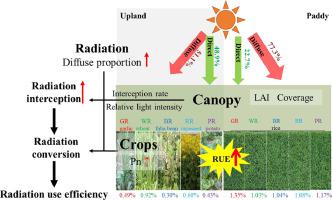Agricultural and Forest Meteorology ( IF 5.6 ) Pub Date : 2023-05-25 , DOI: 10.1016/j.agrformet.2023.109527 Qi Liu , Zhiping Yang , Wei Zhou , Tao Wang , Yong Fu , Xueping Yue , Hong Chen , Youfeng Tao , Fei Deng , Xiaolong Lei , Wanjun Ren , Yong Chen

|
Solar radiation affects crop productivity in farmland ecosystems. Global dimming has resulted in decreased incident global radiation over recent decades, with a huge subsequent effect on food security. Attempting to increasing utilization of radiation and production to increase output, especially in multiple cropping systems, is a significant problem in low-light regions. Here, five upland–paddy cropping systems were evaluated in a low-light region during 2016–2017 and 2017–2018: Garlic–rice (GR), wheat–rice (WR), broad bean–rice (BR), rapeseed–rice (RR), and potato–rice (PR). Solar radiation and crop-related indicators were investigated to determine radiation utilization. The results showed that annual global radiation was 4056.97. MJ·m−2 and 3985.43 MJ·m−2 in 2016–2017 and 2017–2018, respectively, 14.32%–29.92% of which was wasted during the fallow season. Furthermore, the seasonal distribution of global radiation was differed to study years. The ratio_dif in paddy season was greater than 75%, whereas in upland season was less than 55%. Additionally, the annual radiation utilization efficiency (RUE) values of the crops investigated in this study were 0.53%–0.80% and RUE during upland season were 0.30%–0.95%, compared to 0.99%–1.35% during paddy season. The ratio_dif during paddy season had a greater contribution to RUE than that of the upland season, whilst the ratio_dif had a positive relationship with RUE. Therefore, in the low light region the high radiation utilization of upland-paddy systems could primarily be attributed to the efficient utilization of diffuse radiation by rice, which had a high radiation interception, net photosynthesis and net assimilation rate. This increase in diffuse radiation will further promote the efficient use of radiation in low-light regions. Furthermore, planting the upland crops with long growth period (garlic) and high planting intensity (wheat and rapeseed) could take advantage of limited global radiation in low-light regions. Our study clarifies RUE magnitude and its causes in upland–paddy cropping systems in low-light regions, while also providing a theoretical reference for grain production prediction and crop RUE improvement within the context of global dimming.
中文翻译:

稻季漫辐射促进弱光区五种旱稻种植制度的太阳辐射利用
太阳辐射影响农田生态系统的作物生产力。近几十年来,全球变暗导致全球辐射事件减少,随后对粮食安全产生巨大影响。试图增加辐射和生产的利用以增加产量,特别是在复种制度中,是弱光地区的一个重要问题。在此,在 2016-2017 年和 2017-2018 年期间在低光照地区对五种旱稻种植系统进行了评估:大蒜-水稻 (GR)、小麦-水稻 (WR)、蚕豆-水稻 (BR)、油菜-水稻(RR) 和马铃薯-水稻 (PR)。研究了太阳辐射和作物相关指标以确定辐射利用率。结果显示,全球年辐射量为4056.97。MJ· m − 2和 3985.43 MJ·m − 22016-2017 年和 2017-2018 年,分别有 14.32%–29.92% 的粮食在休耕期被浪费。此外,全球辐射的季节性分布因研究年份而异。水稻季节ratio_dif大于75%,而旱季小于55%。此外,本研究调查的作物年辐射利用效率 (RUE) 值为 0.53%–0.80%,旱季 RUE 为 0.30%–0.95%,而水稻季为 0.99%–1.35%。稻季ratio_dif对RUE的贡献大于旱季,ratio_dif与RUE呈正相关。因此,在弱光区域,旱稻系统的高辐射利用主要归因于水稻对漫射辐射的有效利用,具有较高的辐射拦截、净光合作用和净同化率。这种漫射辐射的增加将进一步促进低光区域辐射的有效利用。此外,种植生长期长(大蒜)和种植强度高(小麦和油菜籽)的旱地作物可以利用低光照地区有限的全球辐射。我们的研究阐明了弱光地区旱稻种植系统的 RUE 大小及其成因,同时也为全球变暗背景下的粮食生产预测和作物 RUE 改善提供了理论参考。种植生长期长(大蒜)和种植强度高(小麦和油菜籽)的旱地作物可以利用低光照地区有限的全球辐射。我们的研究阐明了弱光地区旱稻种植系统的 RUE 大小及其成因,同时也为全球变暗背景下的粮食生产预测和作物 RUE 改善提供了理论参考。种植生长期长(大蒜)和种植强度高(小麦和油菜籽)的旱地作物可以利用低光照地区有限的全球辐射。我们的研究阐明了弱光地区旱稻种植系统的 RUE 大小及其成因,同时也为全球变暗背景下的粮食生产预测和作物 RUE 改善提供了理论参考。











































 京公网安备 11010802027423号
京公网安备 11010802027423号